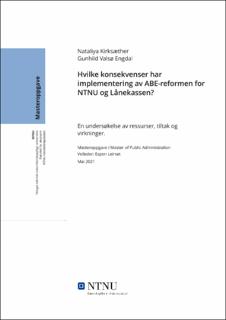| dc.contributor.advisor | Leirset, Espen | |
| dc.contributor.author | Kirksæther, Nataliya | |
| dc.contributor.author | Engdal, Gunhild Valsø | |
| dc.date.accessioned | 2021-09-22T16:05:35Z | |
| dc.date.available | 2021-09-22T16:05:35Z | |
| dc.date.issued | 2021 | |
| dc.identifier | no.ntnu:inspera:82754265:84739800 | |
| dc.identifier.uri | https://hdl.handle.net/11250/2780521 | |
| dc.description.abstract | Denne masteroppgaven har undersøkt hvilke konsekvenser ABE-reformen har for NTNU og Lånekassen. ABE-reformen har som mål å skape en mer omstillingsvillig sektor og med dette en effektiv statlig drift, der et årlig kutt i driftsbevilgningene skal være med å motivere sektoren til å effektivisere driften og dermed produsere de samme tjenestene til en lavere kostnad. Gevinsten av denne effektiviseringen skal skape mer handlingsrom til å finansiere andre prioriterte områder til nytte for fellesskapet. For å undersøke problemstillingen har vi analysert årsrapporter og tildelingsbrev i perioden 2015-2020 samt gjennomført dybdeintervjuer med et utvalg informanter i begge organisasjonene.
Vi fant en del likheter mellom NTNU og Lånekassen om hvordan reformen virker, men også en god del ulikheter. Gjennom tre forskningsspørsmål undersøkte vi om hva som påvirker implementeringen av reformen, hvilke tiltak som er iverksatt og planlegges framover og hvilken innvirkning reformen har på innovasjon og ny teknologi. I vår analyse har vi sannsynliggjort at utgangspunktet for effektivisering ved starten av reformen var forskjellig i organisasjonene. Både Lånekassen og NTNU har blitt påvirket av andre reformer og politiske endringsprosesser, noe som gjør det vanskelig å skille ABE-reformens konsekvenser fra andre endringstiltak. Begge organisasjonene har hatt en nedbemanning og en økning i oppgaveløsningene, samt innført mange store og små effektiviseringstiltak med hovedvekt på digitalisering, redusert bemanning, omorganiseringer og endrede arbeidsprosesser. Vi fant at ABE-reformen kan bli en bremsekloss for utviklingen framfor å bygge opp under nye teknologiløsninger, siden ny teknologi krever store beløp i investeringer og ikke minst budsjett til framtidig drift. Vår undersøkelse viser også at det er motsetning mellom ABE-reformens mål og virkemidler ved at virksomhetene får kutt i bevilgning før effektivisering har skjedd. Samtidig sier flere av våre informanter i undersøkelsen at ABE-reformen kan være et insentiv for effektivisering, i og med at kutt i budsjetter tvinger organisasjoner til å finne nye tiltak for kostnadsreduksjon. Verken informantene til NTNU eller Lånekassen anser ABE-reformen som årsak til effektivisering, men mer som et redskap for omfordeling av midler fra politisk hold. | |
| dc.description.abstract | This thesis has examined the consequences of the ABE reform for NTNU and Lånekassen. The ABE reform aims to create a more adaptable sector and more efficient management structure, where a cut in the annual grants will motivate the sector to streamline operations and to deliver the same services at a lower cost. The benefits of this streamlining will create more flexibility to fund other priority areas for the benefit of the community. To investigate this issue, we have analyzed annual reports and award letters during the period 2015-2020 and conducted in-depth interviews with a selection of participants in both organizations.
We found several similarities between NTNU and Lånekassen in how the reform works, but also some differences. Through three research questions, we have investigated what kind of conditions influence the implementation of the reform, which efficiency measures have been implemented and are planned in the future, and what impact the reform has on innovation and new technology. In our analysis, we can show that the extent of efficiency at the beginning of the reform differed between the two organizations. Both Lånekassen and NTNU have been affected by other reforms and political change processes, which makes it difficult to separate the consequences of the ABE reform from other change processes. Both organizations have undergone a reduction in the workforce and had an increase in the workload. In addition, various efficiency measures have been introduced in the organizations, with the main emphasis on digitization, workforce reduction, reorganizations and changes to work flow. We found that the ABE reform can be an obstacle to development, rather than an encouragement to invest in new technology solutions, since new technology requires organizations to have budgets available for investments and, not least, budgets to cover future operating costs. Our survey also shows that there is a contradiction between the ABE reform's goals and the reform’s instruments, since the organizations receive cuts in funding before efficiency improvements have been made. At the same time, several of the participants in our survey say that the ABE reform can be an incentive for efficiency since budget cuts force organizations to find new measures for cost reduction. Neither the participants from NTNU nor Lånekassen consider the ABE reform as a tool for improving the efficiency, but see the reform more as a political tool for redistributing funds. | |
| dc.language | nob | |
| dc.publisher | NTNU | |
| dc.title | Hvilke konsekvenser har implementering av ABE-reformen for NTNU og Lånekassen?
En kvalitativ undersøkelse av ressurser, tiltak og virkninger. | |
| dc.type | Master thesis | |
